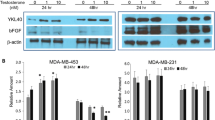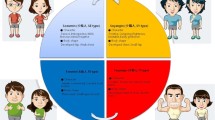Summary
Non-steroidal anti-inflammatory drugs (NSAIDs) are thought to reduce cancer risk by inhibiting cyclo-oxygenases, resulting in deceased formation of inflammatory mediators and oxidative stress. We examined whether the level of one oxidative stress marker, 15-F2t-isoprostane, was affected by NSAID use in plasma and breast nipple aspirate fluids (NAF) of pre-menopausal women who were participating in a dietary intervention trial (n=121). Baseline levels of 15-F2t-isoprostane were lower in NSAID users than non-users in both NAF and plasma, although the differences did not persist after intervention. Over the duration of the study, information on NSAID use was collected five times, and average 15-F2t-isoprostane levels in both NAF and plasma exhibited a statistically significant trend for decreases with increased frequency of NSAID use. These results indicate that NSAID use can result in lower levels of 15-F2t-isoprostane, which may have implications for the effects of NSAID use on breast cancer risk.
Similar content being viewed by others
References
Khuder SA, Mutgi AB,: Breast cancer and NSAID use: a meta-analysisBr J Cancer 84: 1188–1192, 2001
Jacobs EJ, Thun MJ, Connell CJ, Rodriguez C, Henley SJ, Feigelson HS, Patel AV, Flanders WD, Calle EE: Aspirin and other nonsteroidal anti-inflammatory drugs and breast cancer incidence in a large U.S. cohortCancer Epidemiol Biomarkers Prev 14: 261–264, 2005
Terry MB, Gammon MD, Zhang FF, Tawfik H, Teitelbaum SL, Britton JA, Subbaramaiah K, Dannenberg AJ, Neugut AI: Association of frequency and duration of aspirin use and hormone receptor status with breast cancer risk JAMA 291: 2433–2440, 2004
Cook NR, Lee IM, Gaziano JM, Gordon D, Ridker PM, Manson JE, Hennekens CH, Buring JE,: Low-dose aspirin in the primary prevention of cancer: the Women’s Health Study: a randomized controlled trial JAMA 294: 47–55, 2005
Garcia Rodriguez LA, Gonzalez-Perez A: Risk of breast cancer among users of aspirin and other anti-inflammatory drugsBr J Cancer 91: 525–529, 2004
Swede H, Mirand AL, Menezes RJ, Moysich KB: Association of regular aspirin use and breast cancer riskOncology 68: 40–47, 2005
Johnson TW, Anderson KE, Lazovich D, Folsom AR,: Association of aspirin and nonsteroidal anti-inflammatory drug use with breast cancerCancer Epidemiol Biomarkers Prev 11: 1586–1591, 2002
Zhang Y, Coogan PF, Palmer JR, Strom BL, Rosenberg L,: Use of nonsteroidal anti-inflammatory drugs and risk of breast cancer: the Case-Control Surveillance Study revisitedAm J Epidemiol 162: 165–170, 2005
Bundred NJ, Barnes NL,: Potential use of COX-2-aromatase inhibitor combinations in breast cancerBr J Cancer 93(Suppl 1): S10–15, 2005
Kadiiska MB, Gladen BC, Baird DD, Graham LB, Parker CE, Ames BN, Basu S, Fitzgerald GA, Lawson JA, Marnett LJ, et al: Biomarkers of oxidative stress study III. Effects of the nonsteroidal anti-inflammatory agents indomethacin and meclofenamic acid on measurements of oxidative products of lipids in CCl4 poisoningFree Radic Biol Med 38: 711–718, 2005
Morrow JD, Roberts LJ, 2nd,: Mass spectrometric quantification of F2-isoprostanes in biological fluids and tissues as measure of oxidant stress. Methods Enzymol 300: 3–12, 1999
Proudfoot J, Barden A, Mori TA, Burke V, Croft KD, Beilin LJ, Puddey IB,: Measurement of urinary F(2)-isoprostanes as markers of in vivo lipid peroxidation-A comparison of enzyme immunoassay with gas chromatography/mass spectrometryAnal Biochem 272: 209–215, 1999
Klein T, Reutter F, Schweer H, Seyberth HW, Nusing RM,: Generation of the isoprostane 8-epi-prostaglandin F2alpha in vitro and in vivo via the cyclooxygenasesJ Pharmacol Exp Ther 282: 1658–1665, 1997
Patrignani P,: Aspirin insensitive eicosanoid biosynthesis in cardiovascular disease. Thromb Res 110: 281–286, 2003
Schweer H, Watzer B, Seyberth HW, Nusing RM,: Improved quantification of 8-epi-prostaglandin F2 alpha and F2-isoprostanes by gas chromatography/triple-stage quadrupole mass spectrometry: partial cyclooxygenase-dependent formation of 8-epi-prostaglandin F2 alpha in humansJ Mass Spectrom 32: 1362–1370, 1997
Chen G, Djuric Z,: Detection of 2,6-cyclolycopene-1,5-diol in breast nipple aspirate fluids and plasma: a potential marker of oxidative stress. Cancer Epidemiol Biomarkers Prev 11: 1592–1596, 2002
Chen G, Heilbrun L, Venkatranamoorthy R, Djuric Z,: Different factors affect changes in 8-isoprostane levels in plasma and breast nipple aspirate fluids during dietary interventionProc Am Assoc Cancer Res 43: 1340, 2004
Petrakis NL,: Studies on the epidemiology and natural history of benign breast disease and breast cancer using nipple aspirate fluid. Cancer Epidemiol Biomarkers Prev 2: 3–10, 1993
Gruenke LD, Wrensch MR, Petrakis NL, Miike R, Ernster VL, Craig JC,: Breast fluid cholesterol and cholesterol epoxides: relationship to breast cancer risk factors and other characteristicsCancer Res 47: 5483–5487, 1987
Wrensch MR, Petrakis NL, King EB, Miike R, Mason L, Chew KL, Lee MM, Ernster VL, Hilton JF, Schweitzer R, et al: Breast cancer incidence in women with abnormal cytology in nipple aspirates of breast fluidAm J Epidemiol 135: 130–141, 1992
Djuric Z, Poore KM, Depper JB, Uhley VE, Lababidi S, Covington C, Klurfeld DM, Simon MS, Kucuk O, Heilbrun LK,: Methods to increase fruit and vegetable intake with and without a decrease in fat intake: compliance and effects on body weight in the Nutrition and Breast Health StudyNutr Cancer 43: 141–151, 2002
Djuric Z, Visscher DW, Heilbrun LK, Chen G, Atkins M, Covington CY,: Influence of lactation history on breast nipple aspirate fluid yields and fluid compositionBreast J 11: 92–99, 2005
Ainsworth BE, Haskell WL, Leon AS, Jacobs DR, Jr., Montoye HJ, Sallis JF, Paffenbarger RS, Jr.: Compendium of physical activities: classification of energy costs of human physical activities. Med Sci Sport Exer 25: 71–80, 1993
Chen G, Heilbrun LK, Venkatramanamoorthy R, Maranci V, Redd JN, Klurfeld DM, Djuric Z,: Effects of low-fat and/or high-fruit-and-vegetable diets on plasma levels of 8-isoprostane-F2alpha in the Nutrition and Breast Health studyNutr Cancer 50: 155–160, 2004
Freund R, Little R,: 1981. Statistical Analysis System (SAS) for Linear Models. Cary, NC: SAS Institute, Inc
Acknowledgements
We thank all the women who participated in the Nutrition and Breast Health Study. This study was supported by the U.S. National Cancer Institute through research grants U01CA77297 to Z. Djuric and R01CA93817 to I. Kato. Chandice Covington, RN, PhD helped design the nipple aspiration procedure and device that was used in this study.
Author information
Authors and Affiliations
Corresponding author
Rights and permissions
About this article
Cite this article
Kato, I., Chen, G. & Djuric, Z. Non-steroidal anti-inflammatory drug (NSAID) use and levels of a lipid oxidation marker in plasma and nipple aspirate fluids. Breast Cancer Res Treat 97, 145–148 (2006). https://doi.org/10.1007/s10549-005-9102-y
Received:
Accepted:
Published:
Issue Date:
DOI: https://doi.org/10.1007/s10549-005-9102-y




